#1853-1946)
Explore tagged Tumblr posts
Text
«Воспоминания о прошлом» (Recalling the Past), 1888 г.
Художник Карлтон Альфред Смит (Carlton Alfred Smith, 1853-1946)

#«Воспоминания о прошлом» (Recalling the Past)#1888 г.Художник Карлтон Альфред Смит (Carlton Alfred Smith#1853-1946)
0 notes
Text

Christmas Eve, Carlton Alfred Smith (1853-1946)
#Christmas#Christmas Eve#art#art history#Carlton Alfred Smith#genre painting#genre art#interior#British art#English art#19th century art
503 notes
·
View notes
Text

Obra: NIÑO REMENDANDO SU CAMISA.
Artista: ALFRED SMIT(1853-1946).
Fue un acuarelista, pintor al óleo y artista de género [británico](https://www.tuttartpitturasculturapoesiamusica.com/2014/08/British-Artists.html) que a menudo realizó imágenes de interiores de cabañas que mostraban la vida doméstica y figuras en los interiores de las cabañas de una manera romántica hacia fines del siglo XIX.
Era hijo de un grabador de acero y pasó parte de sus primeros años educándose en Francia.
El artista también estudió en la Escuela de Arte Slade, ganando medallas de oro y plata.
Se convirtió en uno de los acuarelistas técnicamente más consumados del final del período victoriano.
21 notes
·
View notes
Text
the hatford family history, as made up by me
disclaimer: this is an entirely made up family history that is based solely off of really quick google searches on life expectancies and such, if its not compatible with canon in places that is my bad also i made this all up so i could write about my oc so just ignore the redacted part of the family tree for the time being, a lot of this is based more on creating a comprehensive family relationship as opposed to making it historically accurate so my apologies

okay so starting from the top we have henry hatford born 1853 died 1893, he is a husbandman in suffolk just outside of ipswich, a lot of land in suffolk was enclosed (common land, which is kind of like parks basically green spaces that are free for anyone to use, was taken by often the rich and wealthy and mostly turned into agricultural land) so henry hatford is a farmer of enclosed land that is owned by like a lord, the agricultural scene in the mid 1800s was in decline i think but the hatfords farm remained fairly successful or at least affloat, imagine they were farming whatever the most popular crop at the time was
henry marries betje hatford nee de boer born 1855 died 1897 and this is where we get to the crime stuff, betje is from amsterdam we're not gonna question too deeply how and why she emmigrated to the uk or how she met henry maybe they had a meet cute when she arrived in london or henry was visiting mainland europe and they met there but either way they met and got married yippee, betje is from amsterdam and thus has family there, as rotterdam began to supplant amsterdam as the most popular port her family became desperate, in 1875 the port of felixstowe was opened and as betje was uniquely positioned near the port and her family were desperate they began a smuggling business, the port was newly formed and as such it was easier to bend the rules, the hatfords are now committing crime! with their new income they are able to buy out the hatfords farming land from whoever owns it and it becomes the hatford family estate, they build a house, likely something that looks similar to bletchley park just not on such a big scale, a victorian house which is larger than a standard suburban victorian home and not terraced but still has the bay windows and all those bells and whistles
so betje and henry hatford are committing crime, whats next? kids of course! their first child is ivo hatford born 1879 died 1922, ivo is their only surviving child, they also have katja hatford 1881-1882 and godfried hatford 1884-1884, as ivo is her only survivng child betje throws her all into him and nurtures him to take over the family business
ivo marries jessamine hatford nee kemp born 1882 died 1828, jessamine and ivo only have one child ingrid hatford born 1905 died 1959, ingrid is raised as the heir to the hatford crime family because betje instilled gender equality for committing crime into ivo, ingrid marries michael hatford nee fisher born 1903 died 1943, michael is obviously not a hatford by birth but was welcomed into the family graciously and decided to take the hatford family name imagine ingrid and michael as a childhood friends to lovers situation, michael dies during the second world war when working on the raf base in woodbridge which is the third point in our triangle of ipswich and felixstowe, the base opened in 1943 and fixed faulty aircraft and we'll say he died in an accident on the base sure
ingrid and michael had four children, three of which survived, edwin hatford born 1924 died 1985, antonis hatford 1926-1930, paula williams nee hatford 1928-1974 and sofia hatford 1929-1980
so paula marries mark williams 1924-1969 and have one child rachel williams 1945-present or at least still alive as the books are taking place
sofia is more interesting sorry not sorry paula, sofia marries paul cranmer 1920-1952 and they have two children lucile hatford nee cranmer 1946-book present and gabriel hatford nee cranmer 1950-book present, when sofia discovers paul has been abusing her children she kills him and begins a rerlationship with her life partner carla samuels 1927-1981, the kids revert to using sofias maiden name and all is happy yippee
back to the main hatford timeline, edwin is ingrid and michaels only surviving son so he gets raised to lead the hatford crime family because the hatford feminist spirit gets lost at some point post ww1
edwin marries theresa hatford nee hardings born 1934 died 1999, theresa and edwin have two children stuart hatford born 1957 and mary hatford born 1962 died 2005 and now we are in canon land so things start to get a little iffy
this is what is canon to me but ive just made this shit up so
theresa is a very demanding mother and puts a lot of pressure and judgement on mary, stuart is raised to be the next hatford heir but when edwin unexpectedly dies in 1985 the hatfords are left a little loose footed, theresa pushes mary to marry nathan and the marriage goes ahead in 1986, the books sort of imply that this was a power alliance kind of marriage or at least not a marriage born of love so the marriage helps to ensure the hatfords stay in power, it probably provided them with some moriyama connections
we can probably expect that if they weren't from the beginning the hatfords are probably now enmeshed in the drugs trade as well as other smuggling endeavors, this new alliance is likely to provide them with connections within america to smuggle things there
so neil is born 1988 and they go on the run in 1998 when he is 10, the books state that neil and mary spent a week in england with stuart and mary didnt want to stay with the hatfords because they were still a dangerous crime family, but what we see of stuart is less violent crime lord and more devoted family man who is also the leader of a crime family
what i propose is mary did not want to return to her family because she didn't want to stay with theresa, who died a year after they went on the run
considering nathan would probably have staged people at all airports on his side of america as soon as he discovered what mary had done, the hatfords smuggling abilities would have come in handy to find a way to extract neil and mary from america under the radar, their smuggling connections within europe would help form the basis for marys european connections and arguably the people who helped forge documents for them
now stuart, as i was coming up with this storyline to flesh out stuart in order to interact with my oc i have i think biased myself to a more positive overall view of stuart personality wise
but anyway now to talk shit about him, i think stuart would be a new labour voter i cant explain why he just gives blairite vibes to me, i think he owns proprty all across the uk and could feasibly be a landlord but also i dont want to make stuart a landlord, of his london properties he probably uses the ones in soho and near canary wharf/greenwich the most
anyway this took me like two hours to write out and all of yesterday to plan, if you intend to use any of this family history could you please credit me, if its not historically accurate then my apologies my english history knowledge unfortantuely has a glaring gap when it comes to the 1800s
#aftg#stuart hatford#mary hatford#neil josten#one (1) person asked for this#i think my laptop might overheat now#also the enclosure stuff is thanks to my a level in history but i did tudor history so this might be outdated#andi posts into the void#6/7/2024#should i start an oc tag? is this an oc tag
11 notes
·
View notes
Text




September 6th 1826 saw the birth of Alison “Eilley” Oram Bowers at a farm near Forfar.
I learned about this extraordinary lady a few years ago, what a life she had, after marrying the first of her three husbands at aged just 15, she emigrated to America at 17 and during the next 60 years she became one of the richest, and most talked about women in the US, outlived three husbands and her children and reinvent herself, after becoming bankrupt as a fortune teller they called The “Seeress of Washoe”.
It is said Alison joined The Church of Jesus Christ of Latter day Saints as means to get across the Atlantic, and so it was after marrying the first of her three husbands, Stephen Hunter at aged just 15, she emigrated to America at 17. Other sources say she never became an actual follower of the Mormons, as they are generally known nowadays, but her Husband was baptised into the faith. I admit a lot of her life story is conjecture and on every occasion I have researched her new information arises.
Following the Mormon custom of her day, her husband, Stephen Hunter, took several wives after they had settled in Utah. Eilley, however, did not enjoy the polygamous lifestyle and soon divorced Hunter. In 1853, she married Alexander Cowan.
The two moved to the Carson Valley where they purchased 300 acres in Washoe Valley. In 1857, Cowan, who was also Mormon, returned to Salt Lake City during troubles between the church and the U.S. government.
Eilley chose to divorce Cowan rather than return to Utah and moved to Johntown, a mining camp below Virginia City, where she opened a boardinghouse.
During this time, she acquired a handful of mining claims from boarders unable to pay their debts and met a Comstock miner, Lemuel “Sandy” Bowers, who would become her third husband.
The two combined their mining holdings and, as luck would have it, ended up owning one of the Comstock’s earliest major silver strikes. Within a short time, the Bowers were among Nevada’s first mining millionaires.
Deciding to spend their seemingly limitless wealth, in 1864, the Bowers’ began building the huge stone mansion on Eilley’s acreage in Washoe Valley. While the home was under construction, they traveled to Europe to purchase furnishings. When it was completed, the mansion was one of the most magnificent homes in the state and the Bowers were willing party hosts. During the next four years, they indulged themselves on the finest clothing, furniture, and collectables.
In 1868, however, Sandy Bowers suddenly died of silicosis at the age of 35. By then, the original mine had become tapped out and he had invested much of their money in several unprofitable mining ventures.
After the estate was finally settled, Eilley found herself penniless. Despite her best efforts to hold on to the mansion, she was unable to keep it. Her misfortune continued when, in 1874, her adopted daughter, Persia, died at the age of 12. Since her days in Salt Lake City, Eilley had been intrigued by the occult.
Apparently during that time she acquired a crystal ball for fortune telling and had prognosticated for friends, although other sources say she brought the “Seer Stone” from her home in Scotland.
In 1875, following her many financial and personal setbacks, Eilley set up shop in Virginia City as the “Washoe Seeress.” Despite skeptics, she practiced her arcane arts for nearly a decade, until the decline of the Comstock.
In the 1880s, she moved to San Francisco, where she worked in various jobs, including–as she had so many years before operating a small boardinghouse. In 1898, she was placed in a rest home in Oakland, where she died in 1903 at the age of 77.
The Bowers Mansion survives and in 1946, it was purchased by Washoe County with the assistance of the Reno Women’s Civic Club and public donations; 20 years later, the property was updated and renovated. Today, it’s Bowers Mansion Regional Park. The home has been restored and refurbished with historic pieces donated by Nevada residents. The grounds contain hiking trails, picnic areas, spring-fed swimming pools, a playground, an amphitheater, and more.
Read more about this Eilley’s story here https://www.nevadawomen.org/research-center/biographies-alphabetical/alison-eilley-oram-bowers/
7 notes
·
View notes
Text
Natale (Xmas)
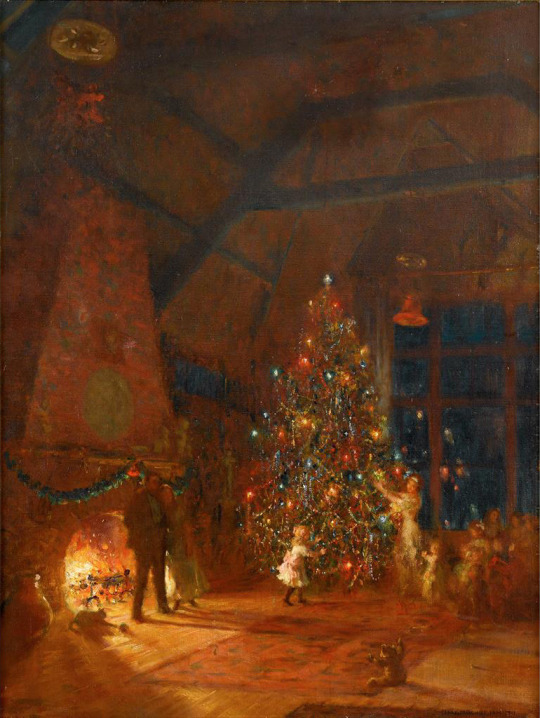
Christmas Eve in the Studio, 1911 ca. | Mary Fairchild Low (1858-1946, USA)
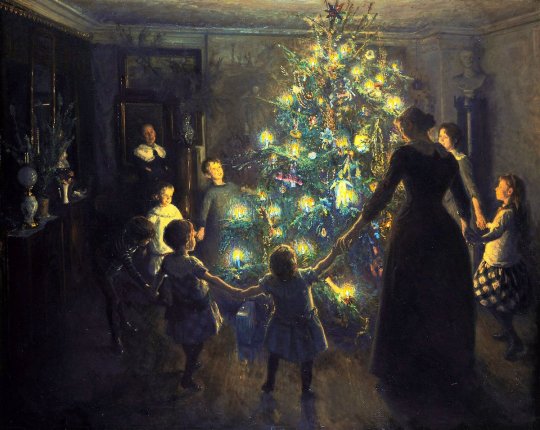
Happy Christmas, 1891 | Viggo Johansen (1851-1935, Denmark)

Christmas in Madison Square Park | Paul Cornoyer (1864-1923, USA)
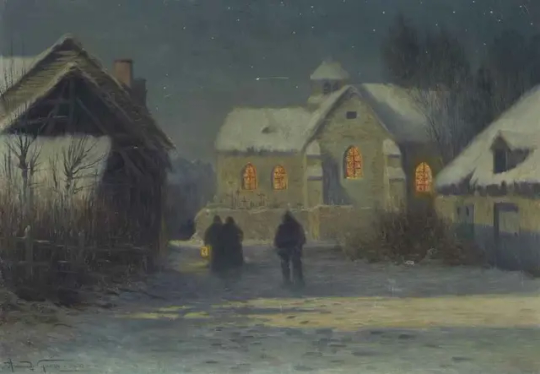
Christmas night in Bertincourt, Champagne, 1900 | Armand Guéry (1853-1912, France)

Noël, Paris | Michel Delacroix (1933, France)

The little Christmas trees, 1950's | Margaret Thomas (1916-2016, England)
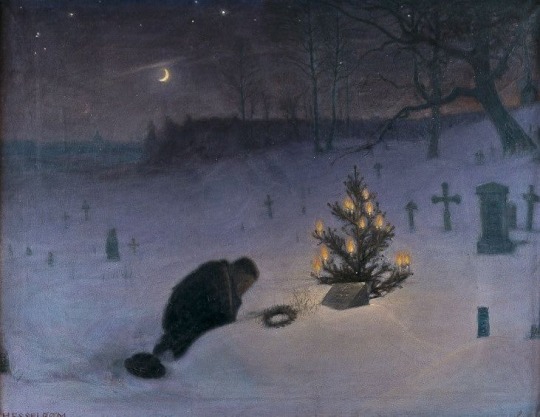
Christmas eve at the grave, 1896 | Otto Hesselbom (1848-1913, Sweden)
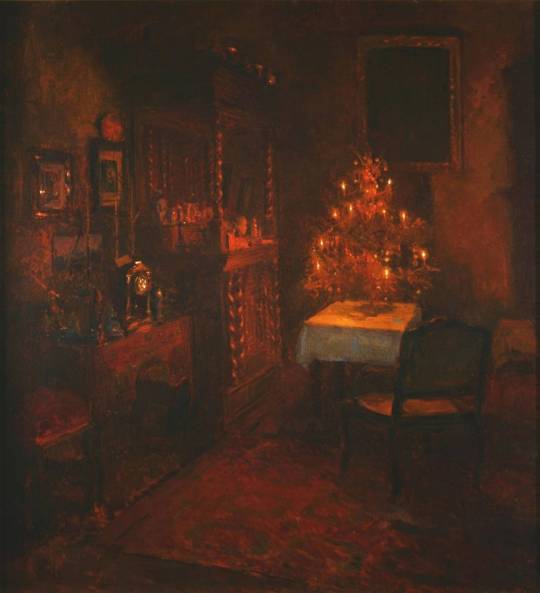
Christmas eve, 1884 | Carl von Marr (1858-1936, Germany)
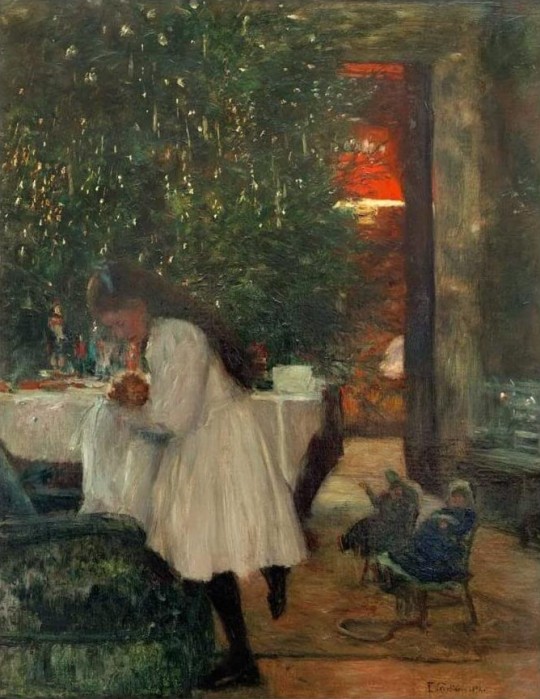
Under the Christmas Tree, 1892 | Franz Skarbina (1849-1910, Germany)
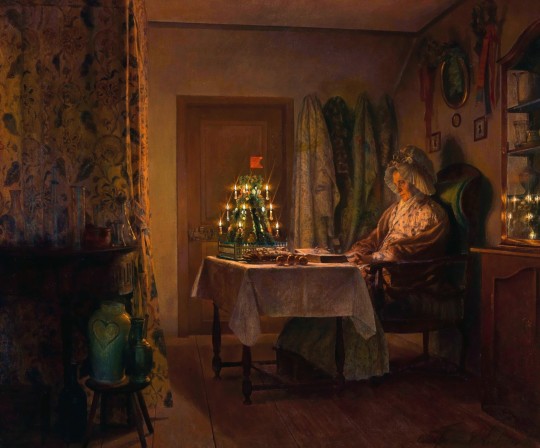
Lonely Christmas | Oskar Freiwirth-Lützow (1862-1925, Germany)
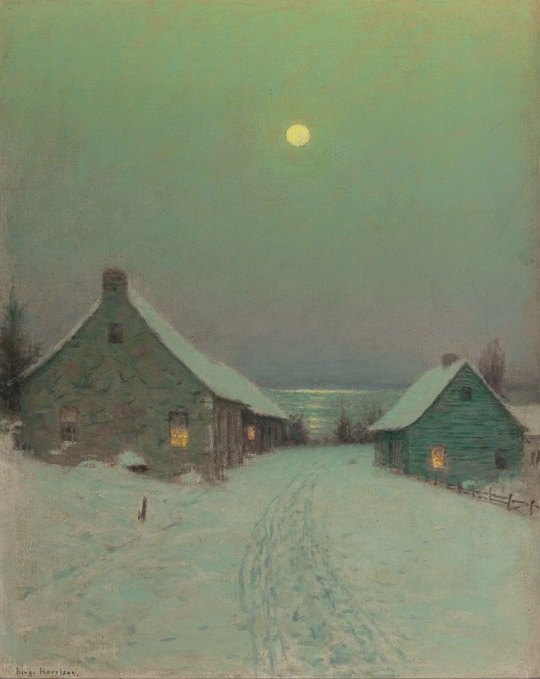
Christmas Eve (La vigilia di Natale), early 1900s | Lovell Birge Harrison (1854-1929, USA)
6 notes
·
View notes
Text
A Beautiful Gate to Hell Part 2

In modern times, Crater Lake has not been able to shake the reputation of it's legends. From the time of being "discovered" by white settlers and into this current year, death and mystery continues to surround the lake. From missing people, to missing aircraft there are a multitude of recorded events that continue to add to the idea that Crater Lake is really a gate to the underworld.
The Missing Persons Missing person stories have become a popular topic on the internet in the last few decades thanks in large part to David Paulides and his conspiracy theories revolving around national parks. As Crater Lake falls under this category, the stories of people just disappearing have been around since the 1850's. In 1853, three explorers went in search of a missing miner who, allegedly, knew where a gold mine was located near the lake. John Hillman has the distinction of being the first reported casualty in the common era, allegedly falling to his death when his horse lost it's footing. The gold mine has never been discovered.
In 1947, a Mr. Cornelius was on the side of the caldera with his wife. He handed his affairs to his wife and fell, or jumped, into the caldera. Being badly beaten, he still had enough strength to drag himself to the lake's waters and drowned. It is unclear if this was an accident or a suicide.
Charles McCuller wears the grim mantle of being the most spoken of missing person in Crater Lake. In 1975 he journeyed to the lake to take photos of the area during winter. He was never seen alive again. The FBI was involved in the search but no trace of him was found until a year later. His remains, only shin and foot bones, were 12 miles from where he had last been spotted in 1975. While his death was ruled natural, the odd nature of his remains was remarked by park rangers to be like "he melted away".
In 2006, an 8 year old boy went missing. Sammy Boehlke disappeared within minutes of his father, Kenneth, losing sight of him near Cleetwood Cove. The search for him lasted months and again included the assistance of the FBI, but no trace has been found of him to this day.
This is only a few of the many individuals who have gone missing in Crater Lake. It is worth to note that Crater Lake is vast, cold, has dense wood, and keeps a snow pack year round. The snow and cold can cause people to slip or do strange things in the throes of hypothermia.
The Missing Aircraft In 1945, a F6F Hellcat crashed into Crater Lake, taking it's pilot with it. While the plane was discovered in 1946, the remains of the pilot were uncovered only in 1970. A park ranger discovered the pilot's skull under a log, appearing to be staring right at him.
In 1975, Dave Nunn with two student pilots went missing over the lake. Jean Nunn, David's wife, recalled being woken up at 9:30PM that night to the feeling of a hand on her leg. When Jean contacted the Klamath Falls Airport, it was revealed the plane was lost at 9:20PM. The aircraft and it's passengers were discovered in 1982 near Huckleberry Campground. In Dave's pocket was a folder piece of paper that read: "Lose not thine airspeed, lest the ground rise up and smite thee."
In 1995, a helicopter carrying three men to Las Vegas crashed into the lake. It sank immediately, taking it's passengers with it. The bodies have not been recovered from the lake, nor has the helicopter been found. It is believe it shattered on impact with the lake and the pieces are too small to be seen on radar.
The Haunted Topography Wizard Island is the newest volcano cone to emerge from the lake, approximately 7,300 years ago. The island has a reputation for having fires randomly appear on it. Some of these fire alleged to have figures standing around it, but at no point has the fires been actually discovered on the island.
The Old Man is a 35 foot tall mountain hemlock that first began to journey in the waters of the lake 400 years ago, but first documented in 1896. The tree stands upright in the water, three feet above and the rest below. Moss that normally grows on the bottom of the lake also grows on the tree. The cold and clear waters allow individuals to see whole of the tree deep into the lake. Old Man is also reported to control the weather around Crater Lake. In 1988 when a submersible planned to explore the lake, Old Man was tied up to keep from accidentally floating into the craft. The weather grew ugly with heavy winds and storm clouds. When the tree was released to meander around the lake, the weather calmed. Allegedly, this is also why park rangers no longer stand on the tree.
sources: Ancient Origins, Crater Lake Institute, Only In Your State, KTVL, Offbeat Oregon
4 notes
·
View notes
Text
Birthdays 4.25
Beer Birthdays
Al Levy (1860)
Cassio Piccolo (1960)
Stephen Beaumont (1964)
Five Favorite Birthdays
Batman; comic book character (1940)
Ella Fitzgerald; jazz singer (1917)
Jason Lee; actor (1970)
Meadowlark Lemon; Harlem Globetroters basketball player (1932)
Edward R. Murrow; broadcast journalist (1908)
Famous Birthdays
Karel Appel; Dutch painter (1921)
Hank Azaria; actor (1964)
Andy Bell; pop singer (1964)
Earl Bostic; saxophonist (1913)
William J. Brennan Jr.; U.S. Supreme Court justice (1906)
Joe Buck; sportscaster (1969)
Ron Clements; animator (1953)
Oliver Cromwell; English politician (1599)
Willis "Gator" Jackson; saxophonnist (1932)
Albert King; blues singer (1923)
Jerry Leiber; pop songwriter (1933)
Guglielmo Marconi; physicist, radio inventor (1874)
Paul Mazursky; film director (1930)
Flannery O'Connor; writer (1925)
Al Pacino; actor (1940)
Eugene “Gene Gene the Dancing Machine” Patton; stagehand, dancer (1932)
Wolfgang Pauli; physicist (1900)
Talia Shire; actor (1946)
John Frank Stevens; Panama Canal engineer (1853)
Renee Zellweger; actor (1969)
1 note
·
View note
Text
BOOKS & FILMS I FIRST READ/WATCHED IN 2022 THAT I RATED 4 OR MORE STARS
BOOKS
I Know Why the Caged Bird Sings (1969) by Maya Angelou
Ways of Seeing (1972) by John Berger
Blacksad (2006) by Juan Díaz Canales & Juanjo Guarnido
Saints and Strangers (1985) by Angela Carter
Discourse on Colonialism (1950) by Aimé Césaire
Stories of Your Life and Others (2002) by Ted Chiang
Are Prisons Obsolete? (2003) by Angela Y. Davis
Demons (1873) by Fyodor Dostoevsky
Absalom, Absalom! (1936) by William Faulkner
33 ⅓: J Dilla’s Donuts (2014) by Jordan Ferguson
Capitalist Realism: Is There No Alternative? (2009) by Mark Fisher
The Black Jacobins: Toussaint L’Ouverture and the San Domingo Revolution (1938) by C.L.R. James
The Broken Heart of America: St. Louis and the Violent History of the United States (2020) by Walter Johnson
Horror: A Very Short Introduction (2021) by Darryl Jones
Red Pill (2020) by Hari Kunzru
White Tears (2017) by Hari Kunzru
Bartleby, the Scrivener (1853) by Herman Melville
Selected Poems (1912 - 1950) by Edna St. Vincent Millay
Socialism: A Very Short Introduction (2005) by Michael Newman
The Sympathizer (2017) by Viet Thanh Nguyen
The God of Small Things (1997) by Arundhati Roy
Antony and Cleopatra by William Shakespeare (1606)
Macbeth by William Shakespeare (1606)
Timon of Athens by William Shakespeare (1605 - 1606)
Wild: From Lost to Found on the Pacific Crest Trail (2012) by Cheryl Strayed
The Little Stranger (2009) by Sarah Waters
The Cambridge Companion to American Gothic (2017) by Jeffrey Andrew Weinstock (ed.)
FILMS
It Happened One Night (1934) dir. Frank Capra
Bicycle Thieves (1948) dir. Vittorio De Sica
The Northman (2022) dir. Robert Eggers
Battleship Potemkin (1925) dir. Sergei Eisenstein
Smoke Signals (1998) dir. Chris Eyre
Let’s Scare Jessica to Death (1971) dir. John Hancock
Grizzly Man (2005) dir. Werner Herzog
The Texas Chain Saw Massacre (1974) dir. Tobe Hooper
Whisper of the Heart (1995) dir. Yoshifumi Kondō
First Blood (1982) dir. Ted Kotcheff
Dr. Strangelove (1964) dir. Stanley Kubrick
Eyes Wide Shut (1999) dir. Stanley Kubrick
M (1931) dir. Fritz Lang
Do The Right Thing (1989) dir. Spike Lee
The Green Knight (2021) dir. David Lowery
My Neighbor Totoro (1988) dir. Hayao Miyazaki
A Matter of Life and Death (1946) dir. Michael Powell & Emeric Pressburger
Pig (2021) dir. Michael Sarnoski
The Fall (2006) dir. Tarsem Singh
Prey (2022) dir. Dan Trachtenberg
Citizen Kane (1941) dir. Orson Welles
The Animatrix (2003) dir. various
#we made an effort to watch a lot of 'film school' type movies this year so that's why some of the films are so highbrow lol#books#movies
16 notes
·
View notes
Note
Hello! Forgive the rather specific request, but do you have a brief recap of the wars Greece fought in modern days? By modern days I mean after guns were invented up to the XX century, excluded (I mean you don't have to mention me WW1 and WW2, as I guess they are already a given). I know for a long time Greece was under the Ottoman empire, so I take that as well
Greece hasn't really fought with others much except Turkey tho lol, the list below will give you a deeper understanding of all the Greco-turkish memes
Guns were used in what we'd call their recognisable form around 1300 AD. For the next 200 years, the Greek fights are still the Byzantine fights.
In the 14th Century, the Byzantine Empire tries to resurrect itself as a result of its utter destruction from the Crusaders. This leads to Byzantine civil wars between aspiring emperors who simultaneously try to regain lands. Meanwhile, the empire fights the Ottomans on numerous battles. Throw in this mix a Byzantine-Genoese War, which had to do with the repercussions of the Crusades.
In the 15th Century, it's all Byzantine Empire vs Ottomans. The empire falls and Greeks become a part of the Ottoman empire.
In the Ottoman-Venetian Wars which span three centuries (1463 - 1718), Greeks participate on the side of the Venetians every time.
During the 16th century, Greeks make several anti-Ottoman revolts, at Vonitsa, Epirus, Thessaly and Dionysius the Philosopher's revolt. They also participate in the Albanian revolt in Himara.
In the Russo-Turkish War (1768-1774), Greeks participate on the side of the Russians.
From 1778-1815, Greeks make several revolts with local success which leads to re-invasions from the Ottoman Turks and more fights.
1821-1832, Greek War of Independence.
Crimean War, 1853 - 1856. Russia VS Ottoman Empire, France and UK. Greeks participate on the side of the Russians.
Further Cretan, Macedonian, Thessalian and Epirote revolts against the Ottoman Empire, 1841 - 1898.
Macedonian Struggle, 1904 - 1908. Atypical war between Greece and Bulgaria over the still Ottoman-controlled region of Macedonia.
First Balkan War, 1912-1913. Greece, Serbia, Montenegro, Bulgaria VS Ottoman Empire.
Second Balkan War, 1913. Greece and Serbia VS Bulgaria.
WWI (1914-1918). Greece joins the Allies after a lot of drama.
Greeks participate in the Allied intervention in the Russian Civil War (1918-1920).
Greco-Turkish War, 1919-1922.
WWII, 1939-1945. Greece is of course on the side of the Allies and fights the invasions of Italy, Germany and Bulgaria, for the most part simultaneously.
Greek Civil War, 1946 - 1949.
Korean War, 1950 - 1953. Greeks participate on the side of South Korea. Fun fact, they were the fifth largest UN power participating in the war.
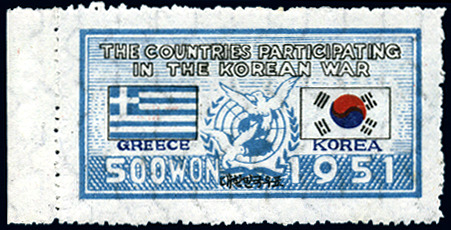
Korean stamp.
Turkish Invasion of Cyprus, 1974. Much weaker and shorter assistance of Cyprus than one would expect, most likely because at the time Greece was governed by a dictatorship.
Now as a member of NATO and UN it is in several expenditions worldwide, missions, but it's basically peacemaking and humanitarian operations etc
13 notes
·
View notes
Text
"Новый фаворит"
Карлтон Альфред Смит (Англия, 1853 - 1946)

1 note
·
View note
Text
#Lucina Hagman (5 June 1853, Kälviä – 6 September 1946) was an early Finnish feminist and among the first female MPs in the world due to the 1907 Finnish parliamentary election #nice
ur government assigned gender for the day is the first thing u get when u click this link to a randomised wikipedia article. NO REROLLS . i am the trollsteineggje mountain in norway
125K notes
·
View notes
Text
Altoid - 1780
Bianchi - 1885
Bic France - 1945
Bicycle PC - 1885
Bigelow - 1838
Brooks brothers - 1818
Budwiser - 1876
Buick - 1903
Canada dry - 1904
Casio - April 1946
Champion - 1919
Chanel - 1910
Chuck Taylor - 1932
Dr. Martin - 1947
Footjoy - 1857
Gucci - 1921
Hoodies - 1930
Izod - 1938
John deer - 1837
John weitz - 1947
Lacoste - 1933
Levi Strauss & Co - 1853
Lv - 1854
Markall b - 1934
Modelo cerveza - 1925
Morris code - 1838
Murrays - 1925
Perrier - 1863
Pinaud - 1810
Rayban - 1937
Rolex - 1905
Schwinn - July 14, 189
S robuck - 1893
Typing - 1875
Volkswagen - 1937
Wrangler - 1947
0 notes
Text
Nuova Caledonia francese: il paradiso in rivolta
La Nuova Caledonia francese scossa da una nuova ondata di proteste contro la "madrepatria". La ex colonia, ora territorio d’oltremare francese, non ha accolto di buon grado la decisione di Parigi di estendere il diritto di voto ai nuovi abitanti francesi dell'isola. Il controllo della Francia sull'intero arcipelago è messo in discussione non solo dalle forze indipendentiste autoctone ma anche dagli interessi commerciali di altri colossi mondiali. Nuova Caledonia francese: dove si trova Nuova Caledonia è un'isola situata nell'Oceano Pacifico sud-occidentale, a circa 1.500 km a est della costa australiana. Un lingua di terra di oltre 18.000 chilometri quadrati, più di 270.000 abitanti, modello di biodiversità. Più di 3.000 sono, infatti, le specie di piante presenti e quasi 70 le specie di uccelli di terra visibili soprattutto nei numerosi parchi e riserve terrestri e marine. L'economia si basa due importanti settori: il turismo e l'estrazione e lavorazione del nichel. Quest'ultimo ha fatto della Nuova Caledonia non solo lo Stato più ricco dell'Oceania ma anche una delle maggiori potenze estrattive al mondo. La popolazione è costituita per il 40% da kanaki, i discendenti degli abitanti originari dell'isola, e per il 60% dai discendenti dei coloni e dei deportati francesi, definiti in modo dispregiativo caldoches dalle popolazioni indigene. I primi abitano per lo più nella zona settentrionale dell'isola, i secondi nella zona meridionale e nella capitale Nouméa. La Nuova Scozia L'isola fu infatti scoperta dall'esploratore britannico James Cook nel 1774 che volle chiamarla Nuova Caledonia in onore della Scozia con la quale condivideva le alte scogliere (Caledonia è il nome latino della Scozia). La sua posizione geografica strategica la rese da subito appetibile alle grandi potenze europee, Regno Unito e Francia in primis. I due Paesi se la contesero a lungo fino a quando nel 1853 la Francia ne assunse il controllo insieme alle vicine Isole della Lealtà (Maré, Lifou, Ouvéa, Tiga, Mouli e Faiava) e Isola dei Pini. Dal 1864 fino ai primi del Novecento fu una colonia penale. Nel 1946 l'arcipelago di Nuova Caledonia è diventato territorio d’oltremare francese. E' un’ex colonia che, pur trovandosi ancora sotto la sovranità dello Stato francese, si amministra in modo semi-indipendente. Dalla metà degli anni Ottanta hanno iniziato a farsi sentire le prime spinte separatiste grazie al Front de Liberation Nationale Kanak Socialiste (FLNKS). Negli anni 2018, 2020 e 2021 si sono svolti tre referendum per l'indipendenza che hanno espresso tutti la volontà della popolazione di rimanere francese. La rivolta antifrancese della Nuova Caledonia La scorsa settimana il parlamento francese ha approvato un emendamento della Costituzione che prevede l'estensione del diritto di voto anche agli abitanti francesi recentemente arrivati in Nuova Caledonia. Una riforma che aumenterebbe ulteriormente il peso della comunità francese a discapito di quella kanaka. Aumenterebbe, di conseguenza, il controllo della Francia sulla sua ex colonia. La notizia della nuova riforma è stata salutata dall'isola con violente proteste. Nella parte settentrionale dell'isola i forti scontri hanno hanno fatto 6 vittime e danni per più di 200 milioni di euro. Giovedì è stato dichiarato lo stato di emergenza e disposto il blocco dell'accesso ai social network. Chi c'è dietro le proteste? Il Fronte indipendentista, che già non aveva riconosciuto il risultato dell'ultimo referendum, è il primo sospettato ma potrebbe non essere l'unico. Una Nuova Caledonia indipendente e ricca di nichel è ambita dalla Cina che mira a conquistare l'egemonia nel Pacifico. Fa gola anche agli Stati Uniti che hanno grossi interessi nella zona, come dimostrano gli ultimi accordi commerciali con l'Australia. In copertina foto di Michael Baragwanath da Pixabay Read the full article
0 notes
Text

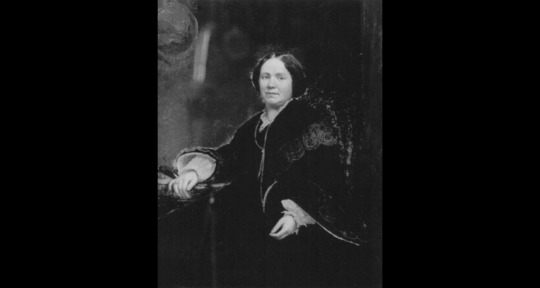
September 6th 1826 saw the birth of Alison “Eilley” Bowers (nee Oram) at a farm near Forfar.
Although she had little interest in religion, she was dissatisfied with her prospects should she remain in Scotland, and is said to have joined The Church of Jesus Christ of Latter day Saints as means to get across the Atlantic, and so it was after marrying the first of her three husbands, Stephen Hunter at aged just 15, she emigrated to America at 17. Other sources say she never became an actual follower of the Mormons, as they are generally known nowadays, but her Husband was baptised into the faith. I admit a lot of her life story is conjecture and on every occasion I have researched her new information arises.
Following the Mormon custom of her day, her husband, Stephen Hunter, took several wives after they had settled in Utah. Eilley, however, did not enjoy the polygamous lifestyle and soon divorced Hunter. In 1853, she married Alexander Cowan.
The two moved to the Carson Valley where they purchased 300 acres in Washoe Valley. In 1857, Cowan, who was also Mormon, returned to Salt Lake City during troubles between the church and the U.S. government.
Eilley chose to divorce Cowan rather than return to Utah and moved to Johntown, a mining camp below Virginia City, where she opened a boardinghouse.
During this time, she acquired a handful of mining claims from boarders unable to pay their debts and met a Comstock miner, Lemuel “Sandy” Bowers, who would become her third husband.
The two combined their mining holdings and, as luck would have it, ended up owning one of the Comstock’s earliest major silver strikes. Within a short time, the Bowers were among Nevada’s first mining millionaires.
Deciding to spend their seemingly limitless wealth, in 1864, the Bowers’ began building the huge stone mansion on Eilley’s acreage in Washoe Valley. While the home was under construction, they traveled to Europe to purchase furnishings.
When it was completed, the mansion was one of the most magnificent homes in the state and the Bowers were willing party hosts. During the next four years, they indulged themselves on the finest clothing, furniture, and collectables.
In 1868, however, Sandy Bowers suddenly died of silicosis at the age of 35. By then, the original mine had become tapped out and he had invested much of their money in several unprofitable mining ventures.
After the estate was finally settled, Eilley found herself penniless. Despite her best efforts to hold on to the mansion, she was unable to keep it. Her misfortune continued when, in 1874, her adopted daughter, Persia, died at the age of 12.
Since her days in Salt Lake City, Eilley had been intrigued by the occult. Apparently during that time she acquired a crystal ball for fortune telling and had prognosticated for friend, although other sources say she brought the “Seer Stone” from her home in Scotland
In 1875, following her many financial and personal setbacks, Eilley set up shop in Virginia City as the “Washoe Seeress.” Despite skeptics, she practiced her arcane arts for nearly a decade, until the decline of the Comstock.
In the 1880s, she moved to San Francisco, where she worked in various jobs, including–as she had so many years before operating a small boardinghouse. In 1898, she was placed in a rest home in Oakland, where she died in 1903 at the age of 77.
The Bowers Mansion survives and in 1946, it was purchased by Washoe County with the assistance of the Reno Women’s Civic Club and public donations; 20 years later, the property was updated and renovated. Today, it’s Bowers Mansion Regional Park. The home has been restored and refurbished with historic pieces donated by Nevada residents. The grounds contain hiking trails, picnic areas, spring-fed swimming pools, a playground, an amphitheater, and more.
Read more about this Eilley's story here https://www.nevadawomen.org/.../alison-eilley-oram-bowers/
4 notes
·
View notes
Text
La Vita 2*
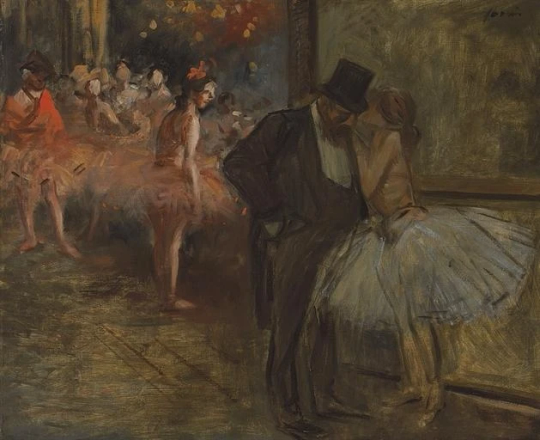
Danseuse et abonné, à l'opéra (le foyer de la danse), 1905 | Jean-Louis Forain (1852-1931, France)
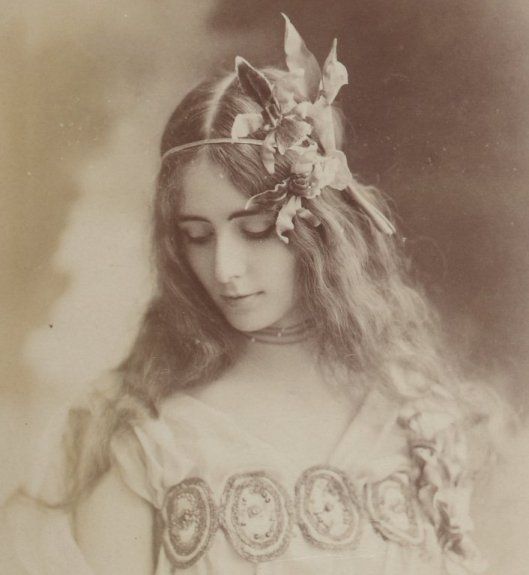
Cléo de Mérode (1875-1966, France)

Cléo de Mérode (1875-1966, France)
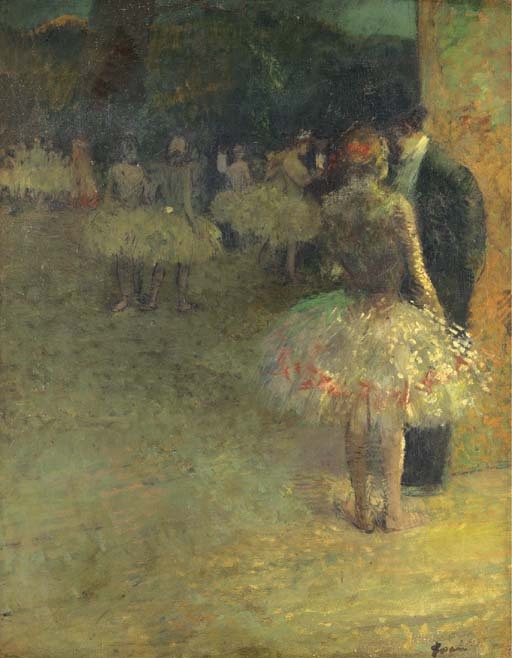
Le dialogue | Jean-Louis Forain (1852-1931, France)
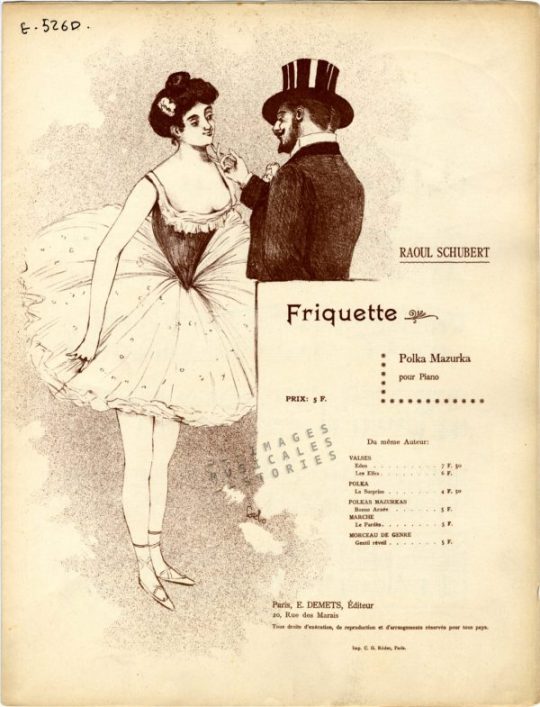
'Friquette' by Raoul Schubert, published by E. Demets (Paris, s.d.). Illustration signed 'Gebo'
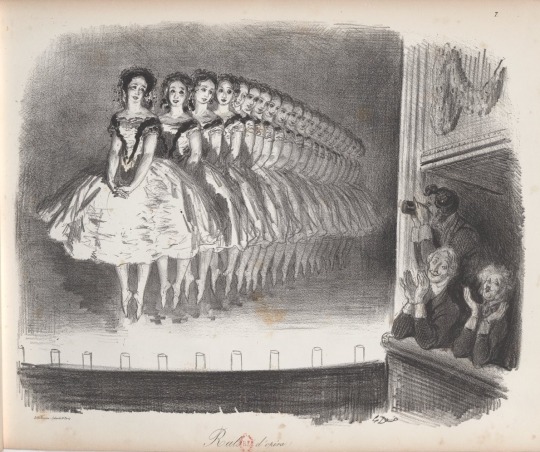
Rats (d’opéra), dans La Ménagerie parisienne, Paris, 1854 | Gustave Doré (1832-1883, France)

Ballerina, 1958 | Sergio Cirno Bissi (1902-1987, Italia)

Ballerina | Sergio Cirno Bissi (1902-1987, Italia)

Scene da un bordello | Gildo De Bonis (1970, Italia)
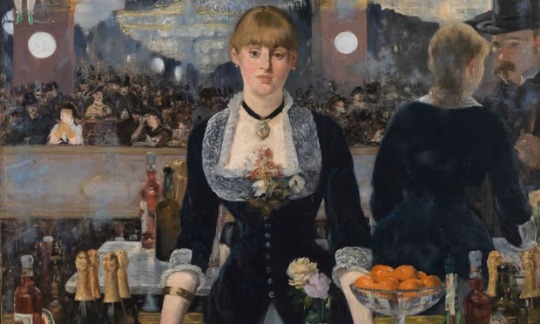
Il bar delle Folies Bergère, 1881-82 (Courtauld Institute Galleries London) | Édouard Manet (1832-1883, France)

Olympia, 1863 (Musée d'Orsay, Paris) | Édouard Manet (1832-1883, France)

Cléo de Mérode (1875-1966, France)

1907 | Mata Hari (1876-1917, Netherlands)
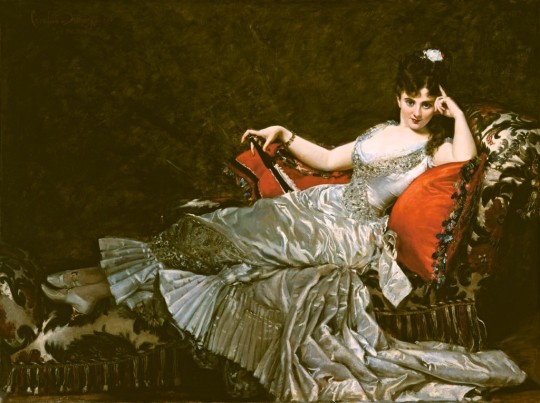
Julia Tahl known as Mademoiselle Alice de Lancey, 1876 (Petit Palais, Musée des Beaux-Arts, Paris) | Charles Carolus-Duran (1837-1917, France)

Le foyer de l'Opéra | Jean-Louis Forain (1852-1931, France)

Derrière les coulisses | Jean-Louis Forain (1852-1931, France)
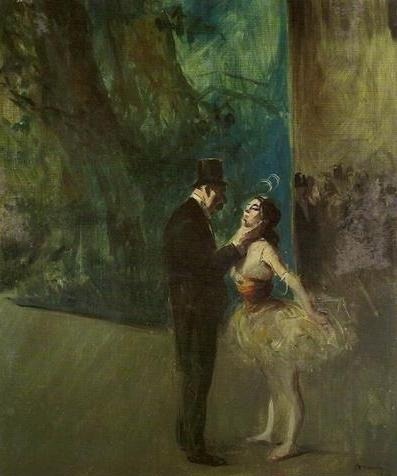
Derrière les coulisses | Henri de Toulouse-Lautrec (1864-1901, France)

Venduta, 1897 | Angelo Morbelli (1853-1910, Italia)

Primo denaro (First money), 1928 | Cagnaccio di San Pietro (1897-1946, Italia)

La toeletta del mattino (in un bordello fiorentino) - The morning toilet (in a Florentine brothel), 1898 | Telemaco Signorini (1835-1901, Italia)

Le danceur, 1890 | Jean-Louis Forain (1852-1931, France)

Symphonie en bleu | Jean-Louis Forain (1852-1931, France)

Dans les coulisses (Dietro le quinte), 1897 | Henri Boutet (1857-1919, France)

L’attente, 1880 | Jean Béraud (1849-1935, France)

L’attente, 1880 | Jean Béraud (1849-1935, France)

The courtesan and the old man, 1522 (The Museum of Fine Arts, Budapest) | Lucas Cranach 'the Elder' (1472-1533, Germany)

Danseur et protecteur | Jean-Louis Forain (1852-1931, France)

Rolla, 1878 | Henri Gervex (1852-1929, France)

Nana, 1877 (Hamburger Kunsthalle) | Édouard Manet (1832-1883, France)

Elle | Gustav-Adolf Mossa (1883-1971, France)
2 notes
·
View notes